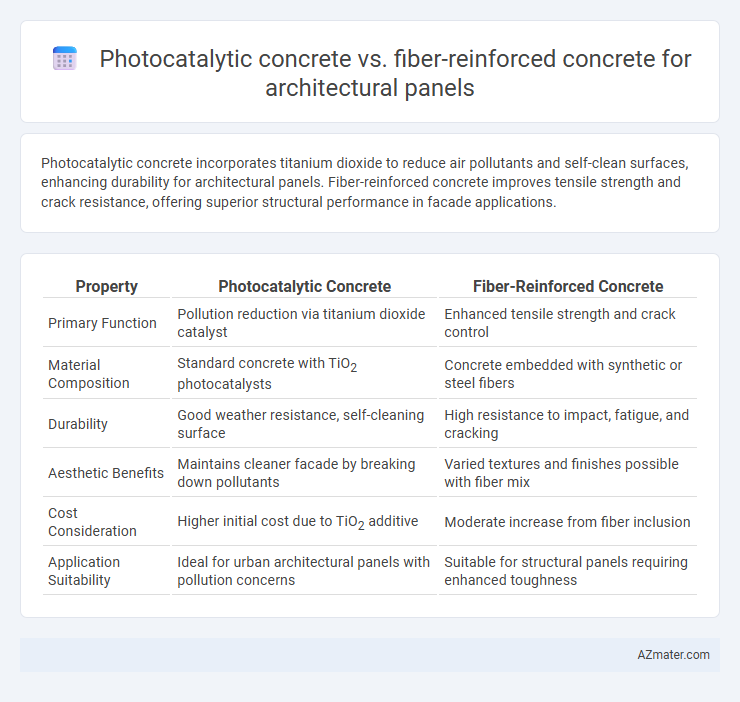Photocatalytic concrete incorporates titanium dioxide to reduce air pollutants and self-clean surfaces, enhancing durability for architectural panels. Fiber-reinforced concrete improves tensile strength and crack resistance, offering superior structural performance in facade applications.
Table of Comparison
| Property | Photocatalytic Concrete | Fiber-Reinforced Concrete |
|---|---|---|
| Primary Function | Pollution reduction via titanium dioxide catalyst | Enhanced tensile strength and crack control |
| Material Composition | Standard concrete with TiO2 photocatalysts | Concrete embedded with synthetic or steel fibers |
| Durability | Good weather resistance, self-cleaning surface | High resistance to impact, fatigue, and cracking |
| Aesthetic Benefits | Maintains cleaner facade by breaking down pollutants | Varied textures and finishes possible with fiber mix |
| Cost Consideration | Higher initial cost due to TiO2 additive | Moderate increase from fiber inclusion |
| Application Suitability | Ideal for urban architectural panels with pollution concerns | Suitable for structural panels requiring enhanced toughness |
Introduction to Architectural Concrete Panels
Architectural concrete panels combine form and function, offering durability with aesthetic versatility for modern construction. Photocatalytic concrete panels incorporate titanium dioxide to break down pollutants, enhancing environmental sustainability and surface self-cleaning properties. Fiber-reinforced concrete panels utilize synthetic or steel fibers to increase tensile strength and crack resistance, improving structural performance and longevity in architectural applications.
Overview of Photocatalytic Concrete
Photocatalytic concrete incorporates titanium dioxide, which actively breaks down airborne pollutants and organic contaminants through light-induced chemical reactions, enhancing urban air quality. This self-cleaning property reduces maintenance costs and preserves the aesthetic appeal of architectural panels over time. Its environmental benefits make it a sustainable choice compared to traditional fiber-reinforced concrete, which primarily improves mechanical strength and durability without offering pollutant degradation.
Advantages of Photocatalytic Concrete Panels
Photocatalytic concrete panels offer superior self-cleaning and pollution-reducing properties by breaking down organic contaminants and harmful pollutants when exposed to sunlight, enhancing urban air quality. These panels exhibit increased durability against environmental degradation, reducing maintenance costs and extending the lifespan of architectural facades. Furthermore, the integration of titanium dioxide in photocatalytic concrete provides a sustainable solution by actively contributing to environmental remediation while maintaining structural integrity.
Overview of Fiber-Reinforced Concrete
Fiber-reinforced concrete (FRC) enhances architectural panel performance by integrating discrete fibers such as steel, glass, or synthetic materials to improve tensile strength, crack resistance, and durability. This composite material provides superior impact resistance and dimensional stability, making it ideal for complex shapes and lightweight structures in modern architecture. FRC panels offer increased longevity and reduced maintenance costs, contributing to sustainable building solutions compared to traditional concrete variants.
Benefits of Fiber-Reinforced Concrete Panels
Fiber-reinforced concrete panels offer exceptional durability and enhanced tensile strength, making them ideal for architectural applications requiring long-lasting performance. Their ability to resist cracking, environmental stress, and impact improves structural integrity while maintaining design flexibility for complex shapes. Compared to photocatalytic concrete, fiber-reinforced panels provide superior mechanical properties and reduced maintenance costs over time.
Durability Comparison: Photocatalytic vs Fiber-Reinforced
Photocatalytic concrete incorporates titanium dioxide to enhance self-cleaning properties and resist environmental pollutants, significantly improving surface durability and reducing maintenance needs. Fiber-reinforced concrete integrates steel or synthetic fibers that increase tensile strength and crack resistance, enhancing structural durability under mechanical stress. While photocatalytic concrete excels in surface longevity and pollution degradation, fiber-reinforced concrete offers superior crack control and toughness, making each suitable for different durability demands in architectural panels.
Aesthetic and Design Flexibility
Photocatalytic concrete offers a unique aesthetic advantage by maintaining cleaner surfaces through its self-cleaning properties, enhancing long-term visual appeal in architectural panels. Fiber-reinforced concrete provides superior design flexibility with improved tensile strength, enabling thinner, more intricate panel shapes and textures without compromising structural integrity. Combining these materials can optimize both surface cleanliness and structural versatility for innovative architectural designs.
Environmental Impact and Sustainability
Photocatalytic concrete significantly reduces air pollutants by breaking down nitrogen oxides (NOx) through photocatalytic reactions, improving urban air quality and contributing to environmental sustainability. Fiber-reinforced concrete enhances structural durability and reduces material usage by improving crack resistance and extending service life, which lowers the environmental footprint related to maintenance and reconstruction. Both materials support sustainable architectural panels by reducing lifecycle environmental impacts, with photocatalytic concrete focusing on active pollution mitigation and fiber-reinforced concrete optimizing resource efficiency.
Cost Considerations for Architectural Projects
Photocatalytic concrete generally incurs higher initial costs due to the integration of titanium dioxide nanoparticles, which provide self-cleaning and pollution-reducing properties, making it suitable for sustainable architectural projects prioritizing long-term environmental benefits. Fiber-reinforced concrete, incorporating synthetic or steel fibers, tends to be more cost-effective with improved mechanical strength and durability, reducing maintenance expenses and enhancing structural performance in architectural panels. Budget-conscious projects often favor fiber-reinforced concrete for lower upfront and lifecycle costs, whereas photocatalytic concrete is preferred when environmental impact and air quality enhancement are critical project goals.
Suitable Applications and Use Cases
Photocatalytic concrete is ideal for urban environments where air pollution reduction and self-cleaning surfaces are essential, making it suitable for facades of commercial buildings and public infrastructure panels. Fiber-reinforced concrete offers enhanced structural strength and crack resistance, perfect for load-bearing architectural panels and exterior claddings requiring durability under mechanical stress. Both materials address specific architectural needs: photocatalytic concrete excels in environmental sustainability, while fiber-reinforced concrete prioritizes mechanical performance and longevity.

Infographic: Photocatalytic concrete vs Fiber-reinforced concrete for Architectural panel
 azmater.com
azmater.com